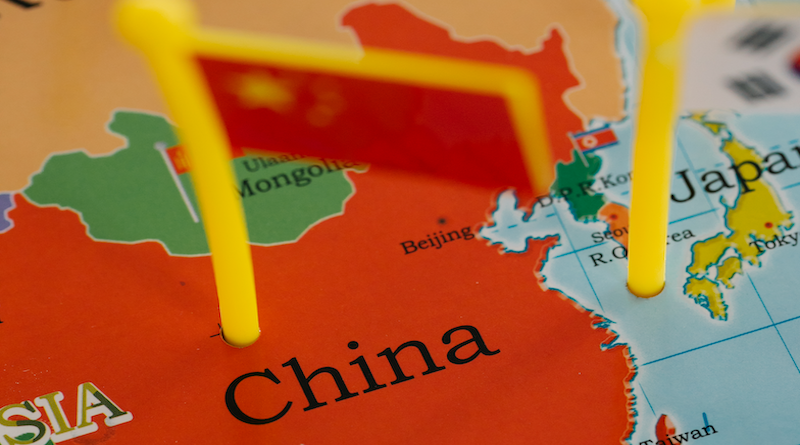Why China Dominated RCEP Poses A Trade Trap Threat: Is India Resilient? – Analysis
With RCEP (Regional Comprehensive Economic Partnership) making its debut in January 2022, after long hard negotiations for over a decade, it emerged as the biggest trade block with duty free access in the world. It accounts for 30 percent of global trade. The noticeable features of RCEP are that first, it is globally east bound trade block, while the larger share of world trade is driven by the west, and secondly, it is immune to any challenge by any trade block, after the fall of TPP, dominated by USA.
RCEP, comprising of 15 nations – ASEAN 10 +5 – is a new challenge to global trade. It is driven by China. It accounts for nearly one-third of intra-RCEP trade. This means, global trade will have multiple leaps in the future, driven by the east.
Given China’s predominance, fears are mounting over Chinese predatory actions in the trade block. China will use this platform to increase its global geopolitical influence and the global trade power. China used similar aggressive moves in grabbing global power through BRI (Belt and Road Initiative), where several smaller nations were dragged into unbearable debt burdens in the name of infrastructure development.
Sri Lanka’s loss of the Hambantota port, Pakistan deepening into huge a trade burden, owing to the China-Pakistan Economic Corridor project and Djibouti, Laos, Zambia and Kyrgyzstan bearing debt exposures to China equivalent to at least 20 percent of their annual GDP, manifest China’s lending diplomacy to increase influence on weaker nations. RCEP is feared to be under similar Chinese clout, with China dumping goods in the trade block and influencing the smaller nations in the block.
The economically weaker and smaller nations of ASEAN are viewed vulnerable to a China trade trap in RCEP. This is because they are import dependent on China for growth. China is the biggest beneficiary of RCEP in terms of market accessibility. In 2019, it held 29.8 percent of exports in intra-RCEP trade, according to a study by UNTACD (An assessment of the Regional Comprehensive Partnership (RCEP) tariff concession).
The bigger the import dependency on China, the greater is the susceptibility to a China trade trap. In 2019, the import dependency of Laos, Myanmar, Cambodia on China were as large as more than one-third of their world imports. This had ripples in intra-RCEP trade. Eventually, import dependence of these nations in RCEP were much higher due to China’s dominance. It was 85 percent for Cambodia, 84 percent for Myanmar and 94 percent for Laos, according to the UNTACD study.
Also, the ASEAN majors are on the brink of vulnerability of trade trap , given the China predominance in RCEP. Most of these majors, viz, Thailand, Malaysia, Indonesia and Indonesia , witnessed widening trade deficit with China, after both were engaged in ASEAN-China FTA in 2010. The trade deficit of ASEAN with China leapfrogged ten times between 2012 to 2021, in the post ASEAN- China FTA.
Japan is the second biggest beneficiary of RCEP. In 2019, it accounted for 13.8 percent in imports and 15.3 percent in exports of intra-RCEP trade, according to UNTACD report. Nevertheless, unlike China, it does not pose a threat to economically weaker and smaller member nations of RCEP. Instead, Japan is viewed to reap benefits for these nations by investing a lot. In 2021, AESEAN was the biggest destination for Japanese overseas investment. It outsmarted investment in USA, the bonhomie destination for Japanese investors. However, Japan’s incentivization of de-coupling from China attributed to growth in Japanese in ASEAN also.
Japanese investment will increase productivity and exports of these nations. They will gear up the competitiveness of these nations and bid challenges to China for low cost manufacturing.
However, even though RCEP is the biggest trade block, it is losing its prominence in the global trade, after China slipped in growth and is engulfed by global trade turmoil post COVID 19. According to the IMF, China’s economic growth slowed drastically in 2022. The USA has been the biggest export destination for China. Since the USA-China face-off and with the onset of COVID pandemic, exports to USA became erratic. China’s exports to USA increased in 2021, after a major fall in 2020. China is now losing the power of global workshops for supply chain.
India withdrew from RCEP at the last moment, anticipating China’s dumping its products in Indian markets. Indian manufacturers argued that it would have been in conflict with Make in India. They alleged that hitherto most of the FTAs remained unsuccessful, given the fact that FTA members reaped more benefits than India. Given this, RCEP would be a further big dent to domestic industry.
Eventually, the windfall was visible. During first nine months of 2022-23 (April-November), India’s dependence on China for electronic components plunged to 34 percent, as compared to 49 percent in 2021-22 (April-March). It is the biggest item for widening the trade deficit. Following suit, dependence on auto components from China dropped to 24 percent during nine months of 2022-23, as compared to 26 percent in 2021-22 (April- March).
In summing up, India’s timely exit from RCEP shielded it from China damaging the domestic industry. However, even though Japan is the second biggest beneficiary in RCEP, apprehensions are not diluted over China’s predatory habits to dig into the Japanese market too, as China does not have a FTA with Japan. Given this, both India and Japan should reinforce IPEF (Indo Pacific Economic Forum) , as a counterweight to RCEP. In fact, China was privately pleased with India’s exit, as it would have been a tough task to ratify.

